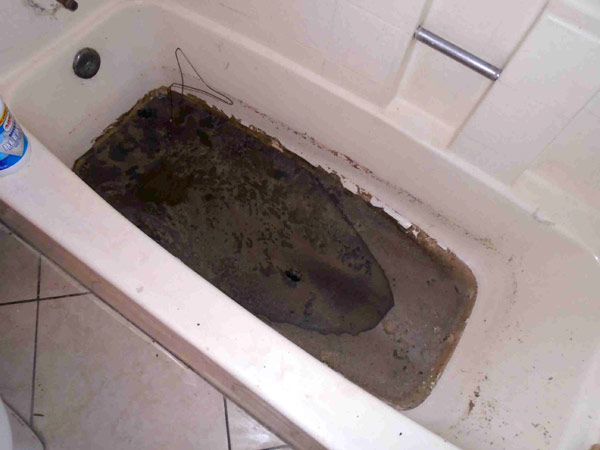We've noticed this article pertaining to What To Do If Sewage Starts Backing Up Into the Shower listed below on the net and think it made sense to discuss it with you over here.

Sewage backup in the bath tub can be a traumatic and unsanitary issue for any type of property owner. Not just is it troublesome, yet it also poses significant health dangers and indicates underlying issues with the plumbing system. Recognizing why sewage is turning up through the bathtub is critical for taking suitable action to deal with the trouble successfully.
Introduction to the Concern
Comprehending the Problem
When sewer starts backing up into the tub, it's a clear sign of an issue with the drain system. The wastewater that needs to be flowing away from your home is instead finding its way back right into your home, which can result in substantial damage and carcinogen.
Prospective Causes
A number of aspects can add to sewer back-up in the bath tub. From obstructions in the drain line to issues with the plumbing facilities, identifying the root cause is essential for finding a service.
Common Factors for Sewage Back-up
Clogs in the Sewer Line
One of one of the most typical reasons for sewage backup is an obstruction in the drain line. This can happen as a result of the accumulation of debris, grease, or foreign objects in the pipes, preventing appropriate circulation and triggering sewer to back up into your bathtub.
Tree Origin Invasion
Tree roots looking for dampness and nutrients can penetrate sewer lines via small fractures or joints. Over time, these origins can grow and increase, causing considerable damages to the pipelines and causing sewer back-up concerns.
Aging Infrastructure
Older homes may have dated plumbing systems that are much more vulnerable to corrosion, cracks, and deterioration. As pipelines age, they become a lot more prone to leakages and clogs, increasing the probability of sewer back-up incidents.
Heavy Rainfall or Flooding
Throughout periods of heavy rainfall or flooding, the sewer system may end up being overwhelmed with excess water, creating back-ups and overflows. This can lead to sewer backing up into bathtubs and other fixtures inside the home.
Health And Wellness Threats Connected With Sewer Backup
Contamination of Supply Of Water
Sewer back-up can infect the water supply in your house, posing a significant health and wellness risk to you and your family. Direct exposure to contaminated water can cause intestinal issues, skin infections, and various other health problems.
Spread of Illness
Sewer contains hazardous bacteria, infections, and parasites that can trigger a range of conditions, including liver disease, cholera, and gastroenteritis. Entering into contact with sewer or polluted surface areas puts you at risk of infection.
Mold and mildew Growth
Dampness from sewer back-up can create ideal conditions for mold and mildew development in your house. Mold and mildew spores can intensify respiratory troubles and cause allergic reactions in delicate people, making prompt cleaning essential.
Indications of Sewer Back-up
Foul Odors
Undesirable odors emanating from drains pipes or components, particularly in the shower room, may suggest sewer backup issues. These odors are commonly strong and consistent, signifying a problem that requires prompt attention.
Slow Draining Fixtures
Tubs, sinks, and bathrooms that drain pipes gradually or otherwise at all could be experiencing sewage back-up. If several fixtures are impacted concurrently, it's most likely that the concern originates from a typical factor, such as the main sewer line.
Gurgling Sounds
Odd gurgling or gurgling noises originating from drains when water is running somewhere else in the house are indicative of air entraped in the plumbing system. This air accumulation can result from sewer back-up and ought to be checked out immediately.
Immediate Actions to Take
Turning Off Water
In the event of sewage back-up, it's vital to turn off the water system to avoid additional contamination and damage. Locate the primary water shutoff valve in your home and shut it off until the problem can be resolved.
Getting In Touch With a Professional Plumber
Dealing with sewer back-up is not a do it yourself job. Get in touch with a qualified plumber with experience in handling sewage-related issues to analyze the scenario and perform required fixings or cleanings.
Preventing Contact with Infected Water
Until the sewage backup is resolved, prevent contact with infected water to stop the spread of microorganisms and pathogens. Use protective equipment if you have to be in the damaged location and clean your hands thoroughly later.
Preventive Measures
Normal Upkeep of Sewer Lines
Set up routine inspections and upkeep of your sewage system lines to identify and deal with potential problems prior to they rise into significant problems. This can consist of clearing out debris, inspecting for tree root invasion, and repairing any type of damaged pipes.
Mounting Bayou Valves
Consider installing backwater valves in your plumbing system to prevent sewer from flowing back into your home during durations of heavy rainfall or flooding. These shutoffs immediately close when water draws back up, safeguarding your home from contamination.
Appropriate Disposal of Home Waste
Stay clear of flushing anything besides toilet tissue and human waste down the commode to stop blockages and blockages in the drain line. Dispose of oil, oil, and various other home chemicals effectively to reduce the risk of plumbing issues.
Cleaning Up After Sewer Backup
Disinfection Procedures
Completely sanitize and sanitize influenced locations after sewer back-up to get rid of damaging germs and prevent mold development. Use appropriate cleaning items and protective gear to guarantee safe and effective cleaning.
Reconstruction of Impacted Areas
Fix any type of damages to floor covering, wall surfaces, or components brought on by sewage backup. Depending upon the degree of the damage, you may need to change carpeting, drywall, or other materials to restore your home to its pre-loss problem.
Why Is Water Backing Up in My Bathtub When I Flush My Toilet?
What to do about a sewer line clog
First, don’t bother with plunging. No amount of plunging will dislodge the clog in a sewer line. The clog is too far away. Plungers are for clogs in the toilet itself, not the sewer line. Plus, the most likely causes of a sewer clog are:
- Tree roots
- Flushed toys or feminine products
- Grease buildup
Those items don’t move easily. And in the case of tree roots, the roots need to be cut out of the pipe and the pipe will need to be repaired.
You’ll need a closet auger. A closet auger is a type of plumber’s snake with a protective cover to keep from scratching the delicate porcelain toilet. If the clog is further down, you may need to remove the toilet or use one of your cleanouts to get to the clog.
We also recommend doing a video inspection of the drain to ensure that the cause of the clog has been completely removed. Otherwise, you could have the same problem again in a few days or weeks.
https://mspplumbingheatingair.com/blog/why-is-water-backing-up-in-my-bathtub-when-i-flush-my-toilet

We hope you liked our topic on Water Coming up Bathtub Drain. Thanks so much for taking the time to browse our blog post. So long as you enjoyed our post please make sure you remember to pass it around. We take joy in your readership.
More Details
Comments on “Scrutinizing the Phenomenon of Drainage Rising Through the Bathtub”